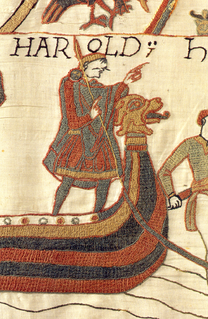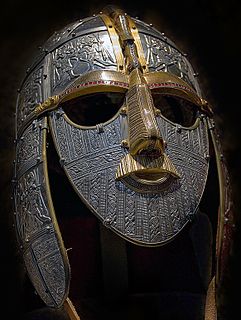 W
WAnglia is a small peninsula within the larger Jutland (Cimbric) Peninsula in the region of Southern Schleswig, which constitutes the northern part of the northernmost German federal state of Schleswig-Holstein, protruding into the Bay of Kiel of the Baltic Sea.
 W
WAnglo-Saxon brooches are a large group of decorative brooches found in England from the fifth to the eleventh centuries. In the early Anglo-Saxon era, there were two main categories of brooch: the long (bow) brooch and the circular (disc) brooch. The long brooch category includes cruciform, square-headed, radiate-headed, and small-long brooch brooches. The long brooches went out of fashion by the end of the sixth century.
 W
WAnglo-Saxon dress refers to the clothing and accessories worn by the Anglo-Saxons from the middle of the 5th century to the eleventh century. Archaeological finds in Anglo-Saxon cemeteries have provided the best source of information on Anglo-Saxon costume. It is possible to reconstruct Anglo-Saxon dress using archaeological evidence combined with Anglo-Saxon and European art, writing and literature of the time period. Archaeological finds have both supported and contradicted the characteristic Anglo-Saxon costume as illustrated and described by these contemporary sources.
 W
WThe Anglo-Saxon settlement of Britain is the process which changed the language and culture of most of what became England from Romano-British to Germanic. The Germanic-speakers in Britain, themselves of diverse origins, eventually developed a common cultural identity as Anglo-Saxons. This process principally occurred from the mid-fifth to early seventh centuries, following the end of Roman rule in Britain around the year 410. The settlement was followed by the establishment of Anglo-Saxon kingdoms in the south and east of Britain, later followed by the rest of modern England, and the south-east of modern Scotland.
 W
WA churl, in its earliest Old English (Anglo-Saxon) meaning, was simply "a man" or more particularly a "husband", but the word soon came to mean "a non-servile peasant", still spelled ċeorl(e), and denoting the lowest rank of freemen. According to the Oxford English Dictionary, it later came to mean the opposite of nobility and royalty, "a common person". Says Chadwick:we find that the distinction between thegn and ceorl is from the time of Aethelstan the broad line of demarcation between the classes of society.
 W
WEaldorman was a term in Anglo-Saxon England which originally applied to a man of high status, including some of royal birth, whose authority was independent of the king. It evolved in meaning and in the eighth century was sometimes applied to the former kings of territories which had submitted to great powers such as Mercia. In Wessex in the second half of the ninth century it meant the leaders of individual shires appointed by the king. By the tenth century ealdormen had become the local representatives of the West Saxon king of England. Ealdormen would lead in battle, preside over courts and levy taxation. Ealdormanries were the most prestigious royal appointments, the possession of noble families and semi-independent rulers. The territories became large, often covering former kingdoms such as Mercia or East Anglia. Southern ealdormen often attended court, reflecting increasing centralisation of the kingdom, but the loyalty of northern ealdormen was more uncertain. In the eleventh century the term eorl, today's earl, replaced that of ealdorman, but this reflected a change in terminology under Danish influence rather than a change in function.
 W
WBurial in Early Anglo-Saxon England refers to the grave and burial customs followed by the Anglo-Saxons between the mid 5th and 11th centuries CE in Early Mediaeval England. The variation of practice performed by the Anglo-Saxon peoples during this period, included the use of both cremation and inhumation. There is commonality in the burial places between the rich and poor - their resting places sit alongside one another in shared cemeteries. Both of these forms of burial were typically accompanied by grave goods, which included food, jewellery and weaponry. The actual burials themselves, whether of cremated or inhumed remains, were placed in a variety of sites, including in cemeteries, burial mounds or, more rarely, in ship burials.
 W
WA thing was a governing assembly in early Germanic society, made up of the free people of the community presided over by lawspeakers. The word appears in Old Norse, Old English, and modern Icelandic as þing, in Middle English, Old Saxon, Old Dutch, and Old Frisian as thing, in German and Dutch as Ding and ding respectively, and in modern Norwegian, Danish, Swedish, Faroese, Gutnish, and Norn as ting, all from a reconstructed Proto-Germanic neuter *þingą; the word is the same as the more common English word thing, both having at their core the basic meaning of "an assemblage, a coming together of parts"—in the one case, an "assembly" or "meeting", in the other, an "entity", "object", or "thing". The meeting-place of a thing was called a "thingstead" or "thingstow".
 W
WHigh-reeve was a title taken by some English magnates during the 10th and 11th centuries, and is particularly associated with the rulers of Bamburgh. It was not however only used by rulers of Bamburgh; many other places used the title; e.g. there was an Ordulf "High-Reeve of Dumnonia".
 W
WA housecarl was a non-servile manservant or household bodyguard in medieval Northern Europe.
 W
WOriginally in Anglo-Saxon England the reeve was a senior official with local responsibilities under the Crown, e.g., as the chief magistrate of a town or district. Subsequently, after the Norman conquest, it was an office held by a man of lower rank, appointed as manager of a manor and overseer of the peasants. In this later role, historian H. R. Loyn observes, "he is the earliest English specialist in estate management."
 W
WThe term thegn, also thane, or thayn in Shakespearean English, comes from the Old English þegn, "servant, attendant, retainer".
 W
WMany different weapons were created and used in Anglo-Saxon England between the fifth and eleventh centuries. Spears, used for piercing and throwing, were the most common weapon. Other commonplace weapons included the sword, axe, and knife—bows and arrows, as well as slings, were not frequently used by the Anglo-Saxons. For defensive purposes, the shield was the most common item used by warriors, although mail and helmets were sometimes used.
 W
WWilmington is the name of a lordship or manor or reputed lordship or manor in Sellindge, in the Folkestone and Hythe borough of Kent, to which the vestigial title Lord of Wilmington relates, which has some of the earliest examples of surviving Anglo-Saxon charters, and is particularly noted for the observation of changes to its placename during its early history. The other Wilmington in Kent is a populous parish, near Dartford.
 W
WThe Witenaġemot, also known as the Witan, was a political institution in Anglo-Saxon England which operated from before the 7th century until the 11th century. The Witenagemot was an assembly of the ruling class whose primary function was to advise the king and whose membership was composed of the most important noblemen in England, both ecclesiastic and secular. The institution is thought to represent an aristocratic development of the ancient Germanic general assemblies, or folkmoots. In England, by the 7th century, these ancient folkmoots had developed into convocations of the land's most powerful and important people, including ealdormen, thegns, and senior clergy, to discuss matters of both national and local significance.
 W
WThe study of the role of women in particular in the society of Anglo-Saxon England has been a topic of academic research in history and gender studies since the 1980s. A seminal study was published by Christine Fell as Women in Anglo-Saxon England in 1984. According to Fell, women were "near equal companions to the males in their lives, such as husbands and brothers, much more than in any other era before modern time". Despite this sense of equality in some strata of society, Anglo Saxon women were still subject to concubinage. Gender was influenced by social status, religion and sexuality. They were not only allowed to have private influence, but also a wide liberty of intervention in public affairs.